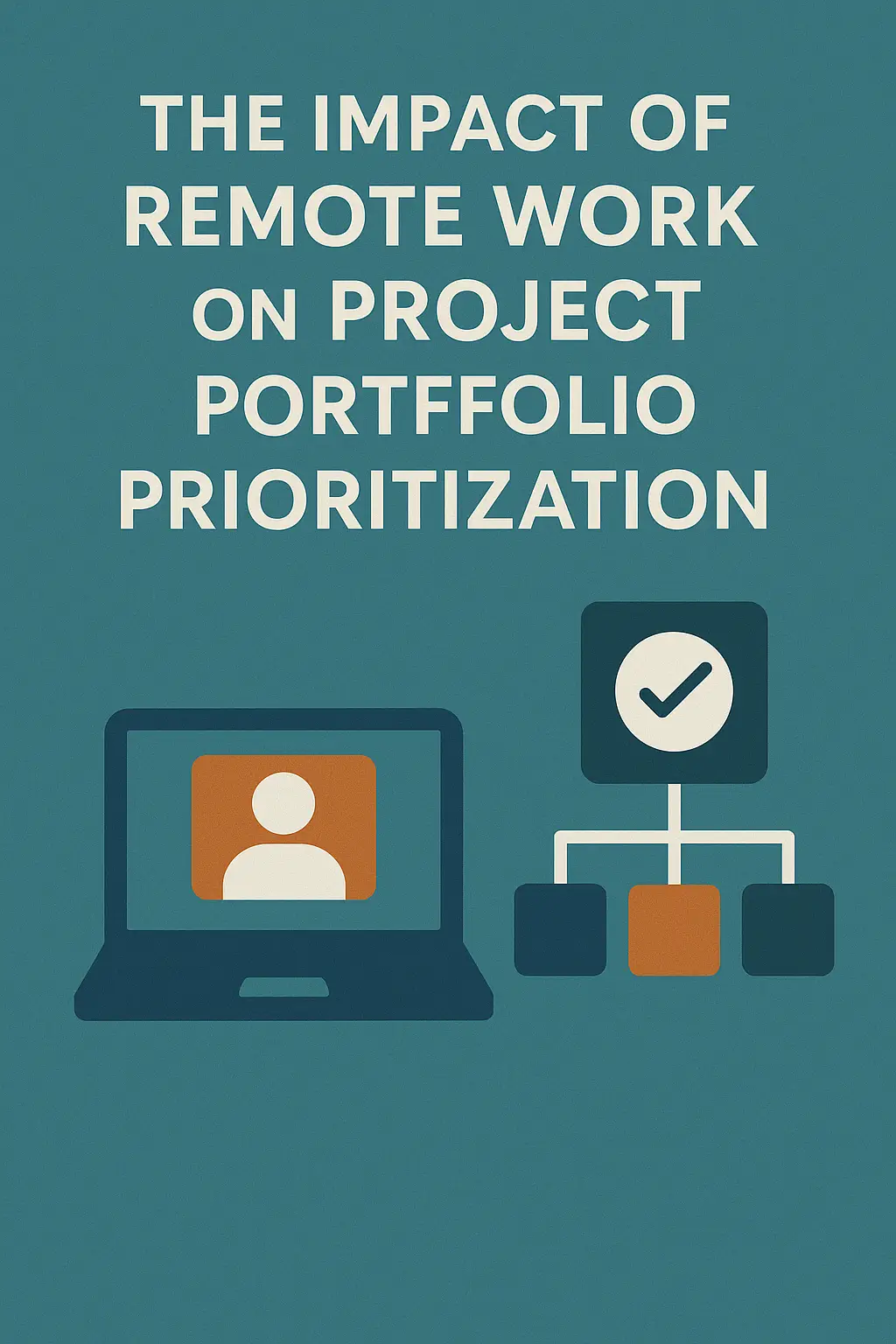Introduction
Project portfolio prioritization is a critical process that involves determining which projects should be undertaken based on their alignment with organizational goals, resource availability, and potential return on investment. This strategic approach ensures that organizations focus their efforts on the most valuable projects, thereby maximizing efficiency and effectiveness in achieving their objectives. By prioritizing projects, teams can allocate resources more effectively, manage risks, and enhance overall project success rates [4][10].
The rise of remote work has significantly transformed the landscape of project management. Over the past few years, particularly accelerated by the global pandemic, many organizations have adopted remote work as a standard practice. This shift has not only changed how teams collaborate but has also introduced new dynamics that influence project execution and management. Remote work environments often require different communication strategies, tools, and workflows, which can complicate traditional prioritization methods [10][14].
The purpose of this blog is to delve into the implications of remote work dynamics on project portfolio prioritization strategies. As remote project teams and managers navigate this evolving work environment, understanding how to adapt prioritization approaches becomes essential. This exploration will provide insights into the challenges and opportunities presented by remote work, ultimately guiding teams in refining their prioritization strategies to ensure continued alignment with organizational goals and successful project outcomes.
Understanding Project Portfolio Prioritization
Project portfolio management (PPM) is a strategic approach that organizations use to manage and prioritize their projects in alignment with their overall business objectives. The primary goal of PPM is to maximize the value delivered by projects while ensuring that resources are allocated efficiently. This involves selecting the right projects to pursue, balancing risk, and ensuring that the portfolio aligns with the organization’s strategic goals. A mature PPM approach emphasizes three key elements: portfolio alignment, ongoing flexibility, and value-driven decision-making, which are crucial for adapting to changing circumstances, such as those brought about by remote work dynamics [2][12].
When it comes to prioritizing projects within a portfolio, several criteria are commonly employed:
- Return on Investment (ROI): This metric assesses the potential financial return of a project relative to its costs. Projects with higher ROI are often prioritized as they promise greater financial benefits to the organization.
- Alignment with Strategic Goals: Projects that directly support the organization’s strategic objectives are given precedence. This ensures that the portfolio contributes to the long-term vision and mission of the organization [13].
- Resource Availability: The availability of necessary resources, including personnel, technology, and budget, plays a critical role in project prioritization. Projects that can be executed with the current resources are often favored to avoid delays and inefficiencies [4][10].
Stakeholder input is another vital component of the prioritization process. Engaging stakeholders—those who have a vested interest in the project’s outcome—ensures that the portfolio reflects diverse perspectives and needs. This collaboration helps in identifying which projects are most critical to the organization and its stakeholders, thereby enhancing the decision-making process. Effective communication with stakeholders from the outset is essential to clarify the rationale behind prioritization decisions and to align expectations [11][9].
In the context of remote work, these prioritization strategies may need to be adapted. The dynamics of remote teams can influence how projects are assessed and prioritized, necessitating a flexible approach that considers the unique challenges and opportunities presented by a distributed workforce. Understanding these foundational elements of project portfolio prioritization is crucial for remote project teams and managers as they navigate the complexities of managing projects in a virtual environment.
The Shift to Remote Work
The transition to remote work has significantly reshaped project management practices. This shift has been driven by several key factors:
- Technological Advancements: The rapid evolution of communication and collaboration tools has made it easier for teams to work together from different locations. Platforms like Zoom, Slack, and project management software have facilitated seamless interactions, enabling remote teams to maintain productivity and engagement despite physical distances.
- Global Events: The COVID-19 pandemic acted as a catalyst for remote work adoption, forcing organizations to adapt quickly to new working conditions. Many companies that previously relied on in-office work were compelled to implement remote work policies, leading to a permanent shift in how teams operate.
Statistics and Trends
Recent studies indicate a significant increase in remote work adoption across various industries. For instance:
- According to a report by Gartner, 47% of organizations plan to allow employees to work remotely full-time post-pandemic, highlighting a long-term commitment to flexible work arrangements.
- A survey by McKinsey found that 80% of employees prefer a hybrid work model, combining remote and in-office work, which suggests that remote work is likely to remain a prevalent option in the future.
These statistics underscore the growing acceptance of remote work as a viable and often preferred mode of operation for many organizations.
Benefits and Challenges
While remote work offers numerous advantages for project teams, it also presents unique challenges that can impact project portfolio prioritization:
Benefits:
– Increased Flexibility: Remote work allows team members to manage their schedules more effectively, which can lead to improved work-life balance and higher job satisfaction.
– Access to a Global Talent Pool: Organizations can hire talent from anywhere in the world, enhancing diversity and bringing in varied perspectives that can enrich project outcomes.
Challenges:
– Communication Barriers: Remote work can lead to misunderstandings and miscommunications, particularly if teams are spread across different time zones. This can complicate project prioritization as stakeholders may have differing views on project urgency and importance.
– Resource Management: Balancing project demand with team capacity becomes more complex in a remote environment. Managers must be adept at assessing team availability and workload to ensure that prioritization aligns with actual capabilities.
The shift to remote work has fundamentally altered the landscape of project portfolio prioritization. As remote project teams and managers navigate this new normal, understanding the dynamics of remote work will be crucial for effective prioritization strategies that align with organizational goals and team capabilities.
Impact of Remote Work on Communication
The shift to remote work has significantly transformed communication dynamics within project teams, which in turn affects project portfolio prioritization strategies. Understanding these changes is crucial for remote project teams and managers aiming to maintain effective collaboration and decision-making processes.
Changes in Interpersonal Communication and Collaboration
Remote work often leads to a more structured form of communication, as spontaneous interactions that typically occur in an office setting are diminished. This can result in feelings of isolation among team members, making it essential for project managers to foster a sense of connection and collaboration despite physical distances. Clear and consistent communication becomes a cornerstone of successful remote project management, as it ensures that all team members are informed and aligned on project priorities. Regular updates, video calls, and instant messaging are vital tools for addressing issues promptly and keeping everyone on the same page [3][7].
Impact of Time Zone Differences
Time zone differences can complicate communication and decision-making processes within remote teams. When team members are spread across various regions, coordinating meetings and discussions can become challenging, potentially leading to delays in decision-making. This can hinder the prioritization of projects, as timely input from all stakeholders is often necessary to assess the urgency and importance of tasks. To mitigate these challenges, teams may need to establish clear protocols for communication that account for time zone differences, ensuring that all voices are heard and considered in the prioritization process [7][12].
Tools and Technologies for Remote Communication
The adoption of various tools and technologies is essential for facilitating effective remote communication. Platforms that support seamless collaboration, real-time communication, and project tracking can significantly enhance the ability of remote teams to prioritize effectively. Tools such as project management software, instant messaging applications, and video conferencing platforms enable teams to stay connected and informed, regardless of their physical locations. By leveraging these technologies, project managers can streamline communication, making it easier to gather input, share updates, and make informed decisions about project priorities [9][14].
The dynamics of remote work have a profound impact on communication within project teams, which directly influences project portfolio prioritization strategies. By understanding these changes and utilizing appropriate tools, remote project teams can enhance their collaboration and decision-making processes, ultimately leading to more effective prioritization of projects.
Resource Allocation in a Remote Environment
The shift to remote work has significantly transformed the landscape of project management, particularly in the realm of project portfolio prioritization. As teams operate from various locations, the dynamics of resource allocation have evolved, presenting both challenges and opportunities for project managers. Here, we will evaluate how remote work affects resource allocation and its implications for project prioritization.
Challenges of Managing Resources Remotely
- Visibility: One of the primary challenges in a remote environment is the lack of visibility into team members’ workloads and progress. Unlike traditional office settings, where managers can easily observe team dynamics and productivity, remote work can obscure these insights. This can lead to difficulties in assessing whether resources are being utilized effectively and whether projects are on track [5].
- Accountability: Remote work can sometimes dilute accountability. With team members working independently, it may be harder to ensure that everyone is meeting their responsibilities. This can complicate the prioritization process, as project managers may struggle to gauge the true status of various projects and the resources allocated to them [9].
Strategies for Effective Resource Allocation in Remote Teams
- Utilizing Technology: Leveraging project management tools and software can enhance visibility and accountability. Tools that provide real-time updates on project status, resource allocation, and team performance can help managers make informed decisions about prioritization. This technology can facilitate better communication and collaboration among remote team members, ensuring that everyone is aligned with project goals [3].
- Regular Check-ins: Establishing a routine of regular check-ins can help maintain accountability and provide insights into team members’ workloads. These meetings can serve as a platform for discussing progress, addressing challenges, and reallocating resources as necessary. This proactive approach can help project managers stay informed and adjust priorities based on current realities [4].
- Clear Guidelines and Expectations: Setting clear expectations regarding roles, responsibilities, and deadlines is crucial in a remote environment. By defining these parameters, project managers can ensure that team members understand their contributions to the project and how their work fits into the larger portfolio. This clarity can enhance accountability and streamline resource allocation [10].
Importance of Flexibility and Adaptability in Resource Prioritization
In a remote work setting, flexibility and adaptability become essential components of effective resource prioritization. The unpredictable nature of remote work—such as varying time zones, personal commitments, and differing work styles—requires project managers to be agile in their approach to resource allocation.
- Dynamic Reallocation: As project needs evolve, the ability to dynamically reallocate resources is vital. Managers should be prepared to shift resources between projects based on changing priorities, team availability, and project timelines. This adaptability can help ensure that the most critical projects receive the attention and resources they need to succeed [7].
- Balancing Risk and Reward: Remote work can introduce new risks, such as communication breakdowns and project delays. Therefore, project managers must balance these risks with the potential rewards of prioritizing certain projects over others. This involves assessing the strategic value of each project and making informed decisions about where to allocate resources for maximum impact [8].
The impact of remote work on project portfolio prioritization is profound. By understanding the challenges of managing resources remotely and implementing effective strategies for resource allocation, project managers can navigate this new landscape successfully. Emphasizing flexibility and adaptability will further enhance their ability to prioritize projects effectively, ensuring that remote teams can thrive in a dynamic work environment.
Changing Prioritization Criteria
The shift to remote work has significantly influenced project portfolio prioritization strategies, compelling organizations to reassess traditional metrics and adapt to new dynamics. Here are some key points to consider:
- Evolving Metrics: In a remote work environment, the criteria for project prioritization are increasingly moving away from conventional metrics such as cost and time. Instead, factors like team morale and work-life balance are gaining prominence. Organizations are recognizing that a motivated and balanced team can lead to higher productivity and better project outcomes. This shift emphasizes the importance of employee well-being as a critical component of project success, aligning with the notion that happy teams are more effective in delivering results [8][14].
- Agility in Prioritization: The uncertainty brought about by remote work necessitates a more agile approach to project prioritization. Organizations are adopting flexible frameworks that allow them to quickly reassess priorities in response to changing circumstances. This agility enables teams to pivot and focus on projects that align with immediate business needs or address emerging challenges, ensuring that resources are allocated effectively even in unpredictable environments [6][10].
- Real-World Examples: Several organizations have successfully adjusted their prioritization strategies in response to remote work dynamics. For instance, a tech company may have shifted its focus from launching new products to enhancing existing ones, prioritizing projects that improve user experience and support remote collaboration tools. Another example could be a healthcare organization that prioritized projects aimed at improving telehealth services, recognizing the increased demand for remote healthcare solutions during the pandemic. These adjustments illustrate how organizations are re-evaluating their project portfolios to align with the realities of remote work and the evolving needs of their teams and clients [5][11].
The impact of remote work on project portfolio prioritization is profound, leading to a reevaluation of traditional metrics and the adoption of more agile, employee-centric strategies. As remote project teams navigate this new landscape, understanding and adapting to these changing criteria will be essential for maintaining productivity and achieving project success.
Leveraging Technology for Prioritization
In the evolving landscape of project management, particularly in the context of remote work, the need for effective project portfolio prioritization has never been more critical. As remote project teams navigate the complexities of distributed work environments, leveraging technology becomes essential to enhance prioritization strategies. Here are some key points to consider:
- Digital Tools for Project Portfolio Prioritization:
Remote teams can benefit significantly from various digital tools designed to streamline project management and prioritization. Project management software such as Asana, Trello, or Monday.com allows teams to visualize their project portfolios, set priorities, and track progress in real-time. Collaboration platforms like Slack or Microsoft Teams facilitate communication and ensure that all team members are aligned on project goals and priorities. These tools not only enhance transparency but also foster a collaborative environment where team members can contribute to prioritization discussions effectively [1][5]. - Data Analytics and Visualization Tools:
The integration of data analytics and visualization tools can greatly enhance decision-making processes for remote teams. By utilizing dashboards and reporting tools, project managers can analyze project performance metrics, resource allocation, and potential risks. This data-driven approach enables teams to make informed decisions about which projects to prioritize based on their alignment with strategic objectives and potential value delivery. Visualization tools can help in presenting complex data in an easily digestible format, allowing for quicker assessments and discussions among team members [10][12]. - Importance of Training and Onboarding:
While technology can significantly improve prioritization strategies, the effectiveness of these tools hinges on the team’s ability to use them proficiently. Therefore, investing in training and onboarding is crucial. Remote teams should ensure that all members are well-versed in the functionalities of the chosen tools and understand how to leverage them for effective prioritization. This includes not only technical training but also fostering a culture of continuous learning and adaptation to new technologies. By equipping team members with the necessary skills, organizations can maximize the benefits of their technological investments and enhance overall project portfolio management [8][14].
As remote work continues to shape the project management landscape, leveraging technology for project portfolio prioritization is essential. By identifying the right digital tools, utilizing data analytics, and prioritizing training, remote project teams can enhance their prioritization strategies, leading to improved project outcomes and alignment with organizational goals.
Best Practices for Remote Project Portfolio Prioritization
Remote work has introduced unique dynamics that significantly influence project portfolio prioritization. For remote project teams and managers, adopting effective strategies is essential to navigate these changes and ensure successful outcomes. Here are some best practices to enhance prioritization processes in a remote work environment:
1. Establish Clear Communication Channels
Effective communication is the cornerstone of successful project management, especially in a remote setting. To facilitate smooth prioritization processes, consider the following:
- Utilize Multiple Communication Tools: Leverage instant messaging, video conferencing, and project management software to maintain open lines of communication. This helps bridge the physical gap and ensures that all team members are aligned on project priorities [2][10].
- Set Regular Check-Ins: Schedule daily or weekly meetings to discuss project statuses and reassess priorities. Regular check-ins foster transparency and allow teams to adapt to any changes in project scope or urgency [2][10].
2. Conduct Regular Reviews and Updates
The nature of remote work often leads to shifting priorities due to changing circumstances. To stay agile, implement the following practices:
- Establish a Routine for Reviews: Create a structured schedule for reviewing project priorities. This could be monthly or quarterly, depending on the pace of your projects. Regular reviews help teams stay responsive to new information and evolving business needs [1][8].
- Adapt to New Information: Encourage teams to be flexible and ready to adjust priorities based on feedback, performance metrics, or external factors. This adaptability is crucial for maintaining project relevance and effectiveness [4][6].
3. Involve Team Members in the Prioritization Process
Engaging team members in the prioritization process not only enhances buy-in but also leverages diverse perspectives. Consider these methods:
- Collaborative Prioritization Sessions: Organize workshops or brainstorming sessions where team members can contribute to the prioritization discussions. This collaborative approach fosters a sense of ownership and encourages innovative ideas [3][14].
- Utilize Prioritization Techniques: Introduce various prioritization frameworks, such as RICE (Reach, Impact, Confidence, Effort) or WSJF (Weighted Shortest Job First), to help teams evaluate projects systematically. These techniques can provide a structured way to assess and rank projects based on their potential value and resource requirements [5][6].
By implementing these best practices, remote project teams can enhance their prioritization processes, ensuring that they remain focused on the most impactful projects. As remote work continues to shape the project management landscape, adapting these strategies will be key to achieving success in a dynamic environment.
Conclusion
The shift to remote work has significantly influenced project portfolio prioritization strategies, necessitating a reevaluation of traditional methods. Key findings from our exploration highlight the following impacts:
- Communication and Collaboration: Remote work can hinder spontaneous interactions, which are often crucial for effective prioritization discussions. Teams must leverage digital tools to maintain open lines of communication and ensure that all stakeholders are aligned on project priorities.
- Flexibility and Adaptability: The dynamic nature of remote work environments requires project managers to be more flexible in their prioritization approaches. This adaptability allows teams to respond swiftly to changing circumstances and emerging project needs, ensuring that the most critical projects receive the attention they deserve.
- Stakeholder Engagement: Engaging stakeholders remotely can be challenging, yet it is essential for successful prioritization. Managers should actively seek input from all relevant parties to ensure that diverse perspectives are considered, which can lead to more informed decision-making.
- Resource Allocation: Remote work may alter resource availability and team dynamics, impacting how projects are prioritized. Managers need to assess their resource allocation strategies regularly to optimize project outcomes in a remote setting.
As remote work continues to evolve, it is crucial for project teams and managers to assess their own prioritization strategies in light of these dynamics. Reflecting on how remote work influences your team’s processes can lead to improved efficiency and project success.
Find out more about Shaun Stoltz https://www.shaunstoltz.com/about/.
This post was written by an AI and reviewed/edited by a human.



